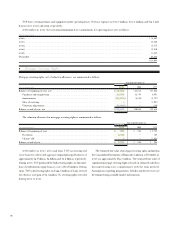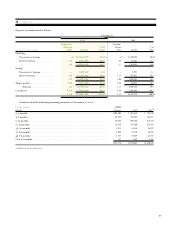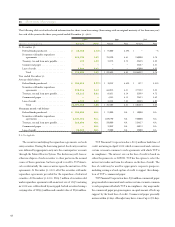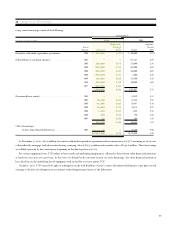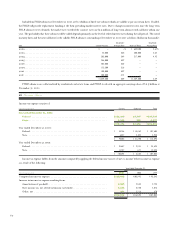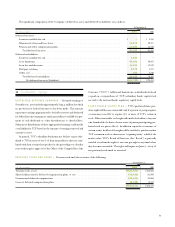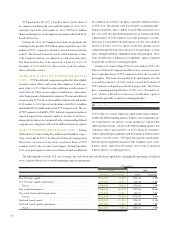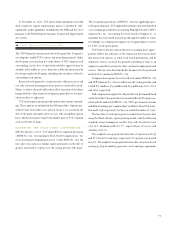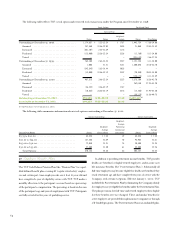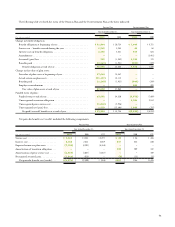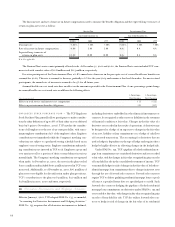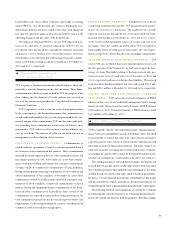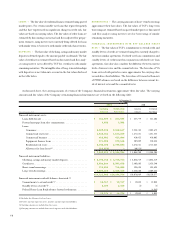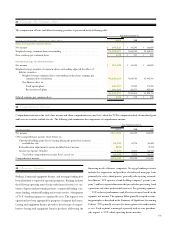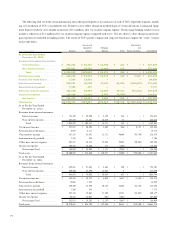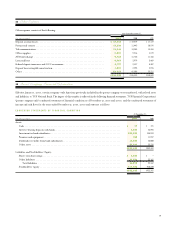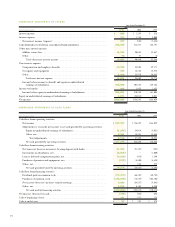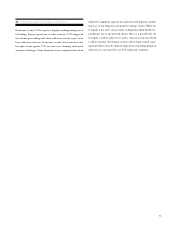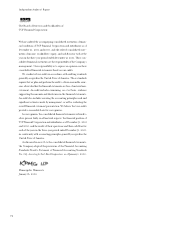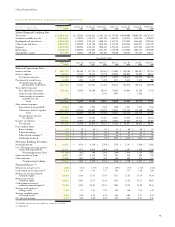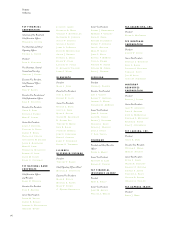TCF Bank 2001 Annual Report Download - page 68
Download and view the complete annual report
Please find page 68 of the 2001 TCF Bank annual report below. You can navigate through the pages in the report by either clicking on the pages listed below, or by using the keyword search tool below to find specific information within the annual report.
66
The discount rate and rate of increase in future compensation used to measure the benefit obligation and the expected long-term rate of
return on plan assets were as follows:
Pension Plan Postretirement Plan
Year Ended December 31, Year Ended December 31,
2001 2000 1999 2001 2000 1999
Discount rate . . . . . . . . . . . . . . . . . . . . . 7.50% 7.50% 7.50% 7.50% 7.50% 7.50%
Rate of increase in future compensation . . 4.50 5.00 5.00 N.A. N.A. N.A.
Expected long-term rate of
return on plan assets . . . . . . . . . . . . . . 10.00 10.00 10.00 N.A. N.A. N.A.
N.A. Not applicable.
The Pension Plan’s assets consist primarily of listed stocks. At December 31, 2001 and 2000, the Pension Plan’s assets included TCF com-
mon stock with a market value of $11.8 million and $11.3 million, respectively.
For active participants of the Postretirement Plan, a 6.8% annual rate of increase in the per capita cost of covered health care benefits was
assumed for 2002. This rate is assumed to decrease gradually to 6% for the year 2004 and remain at that level thereafter. For most retired
participants, the annual rate of increase is assumed to be 4% for all future years.
Assumed health care cost trend rates have an effect on the amounts reported for the Postretirement Plan. A one-percentage-point change
in assumed health care cost trend rates would have the following effects:
1- Percentage- 1- Percentage-
(In thousands) Point Increase Point Decrease
Effect on total service and interest cost components . . . . . . . . . . . . . . . . . . . . . . . . . . . . . . . . . . . . . . . $ 13 $ (12)
Effect on postretirement benefits obligations . . . . . . . . . . . . . . . . . . . . . . . . . . . . . . . . . . . . . . . . . . . . 131 (117)
EMPLOYEES STOCK PURCHASE PLAN – The TCF Employees
Stock Purchase Plan generally allows participants to make contribu-
tions by salary deduction of up to 18% of their salary on a tax-deferred
basis (12% prior to November 1, 2001). TCF matches the contribu-
tions of all employees at the rate of 50 cents per dollar, with a max-
imum employer contribution of 3% of the employee’s salary. Employee
contributions vest immediately while the Company’s matching con-
tributions are subject to a graduated vesting schedule based on an
employee’s years of vesting service. Employee contributions and match-
ing contributions are invested in TCF stock. Employees age 50 and
over may invest all or a portion of their account balance in various
mutual funds. The Company’s matching contributions are expensed
when made. At December 31, 2001, the assets in the plan totaled
$200.2 million and included $197.3 million invested in TCF com-
mon stock. Additionally, as of December 31, 2001, $76.5 million of
plan assets were eligible for diversification under plan provisions.
TCF’s contribution to the plan was $3 million, $2.7 million and
$2.8 million in 2001, 2000 and 1999, respectively.
18 Derivative Instruments and Hedging Activities
Effective January 1, 2001, TCF adopted SFAS No. 133, as amended,
“Accounting for Derivative Instruments and Hedging Activities.”
SFAS No. 133 requires that all derivative instruments as defined,
including derivatives embedded in other financial instruments or
contracts, be recognized as either assets or liabilities in the statement
of financial condition at fair value. Changes in the fair value of a
derivative are recorded in the results of operations. A derivative may
be designated as a hedge of an exposure to changes in the fair value
of an asset, liability or firm commitment or as a hedge of cash flows
of forecasted transactions. The accounting for derivatives that are
used as hedges is dependent on the type of hedge and requires that a
hedge be highly effective in offsetting changes in the hedged risk.
Under SFAS No. 133, TCF’s pipeline of locked residential mort-
gage loan commitments are considered derivatives and are recorded
at fair value, with the changes in fair value recognized in gains on sales
of loans held for sale in the consolidated statements of income. TCF
economically hedges its risk of changes in the fair value of locked res-
idential mortgage loan commitments due to changes in interest rates
through the use of forward sales contracts. Forward sales contracts
require TCF to deliver qualifying residential mortgage loans or pools
of loans at a specified future date at a specified price or yield. Such
forward sales contracts hedging the pipeline of locked residential
mortgage loan commitments are derivatives under SFAS No. 133 and
are recorded at fair value, with changes in fair value recognized in gains
on sales of loans held for sale. TCF also utilizes forward sales con-
tracts to hedge its risk of changes in the fair value of its residential


